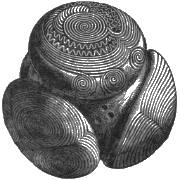Canmore Site 37816: ORONSAY, CARN A' BHARRAICH - COLONSAY AND ORONSAY - INHUMATION(S) (PERIOD UNASSIGNED), SHIP BURIAL (VIKING)
Description
| Site Name | ORONSAY, CARN A' BHARRAICH |
|---|---|
| Other Name(s) | BOAT BURIAL |
| Site Number | NR38NE 4 |
| Broad Class | RELIGIOUS RITUAL AND FUNERARY |
| Site Type(s) | INHUMATION(S) (PERIOD UNASSIGNED), SHIP BURIAL (VIKING) |
| NGR | NR 3606 8833 |
| NGR accuracy | NGR given to the nearest 10m |
| Local Authority | ARGYLL AND BUTE |
| Parish | COLONSAY AND ORONSAY |
| Record created | 1988-03-21 |
| Last updated | 2001-05-08 |
Archaeology Notes
NR38NE 4 3606 8833.
(Area: NR 361 883) Carn nan Bharraich-Cairn of the Men of Barra - a Viking boat burial which was excavated by Sir John McNeill in April, 1891 and by Grieve in June, 1913, revealing three burials, probably two women and a man accompanied by ornaments but no weapons except an iron knife. Before excavation the site was a low, turf-covered mound of sand and schist slabs, and the investigation revealed two narrow stones 4' and 4'6" long whose position suggested that they had stood upright on the summit of the mound. Besides a great number of rivets the finds included two oblong mounts which had been converted into brooches, two tortoise brooches, part of a penannular brooch, an amber bead, fragments of a pair of shears and what may have been a bone needle-case. The finds are in National Museum of Antiquities of Scotland (NMAS I L 329 - 333, 351: F C 185 et seq).
M McNeill 1891; J Anderson 1907; J Grieve 1914; J Curle 1914
The exact site of this burial could not be verified but it is locally believed to be at NR 3606 8833 where there is a rectangular area of stones 1.5m by 1.0m situated loosely on top of a shell-midden (NR38NE 5).
Visited by OS (BS) 12 April 1974
Iron rivets from a Viking boat-burial on Oronsay were collected by Mungo Buchanan and were donated to Royal Museum of Scotland (NMAS, RMAS) by Dunfermline Museum in 1971-2.
Proc Soc Antiq Scot 1974
The excavation,in 1891 (M'Neill 1891)'and 1913, (Ordnance Survey Name Book 1870) of a low mound situted in an area of sand-dunes on the E coast of Oronsay about 1.2 km ESE of Oronsay Priory (RCAHMS 1984 No. 386) uncovered three burials of Viking date and evidence for the burning of a boat.
The presence of a layer of shells 0.15m (6 in.) thick, which may be an indication of Mesolithic activity on the site, was
noted in 1911. (Hunterian Museum Archive P2 {Bu})) The mound has been much damaged by erosion, and, since no stratigraphical relationships were recorded, it is not possible to say whether any of the burials were deposited at the same time.
In 1891 the excavator found 'two narrow stones', 1.22m (4 ft.) and 1.37m (4 ft. 6 in.) long, which he believed to have
originally stood upright on the surface of the mound, and he noted the presence of other slabs in the mound material. Two extended inhumations with the heads to the NNW lay side by side at a level about 1.22m (4 ft.) below the summit. The more easterly skeleton, thought to be that of a woman of considerable age, was accompanied by two brooches,
probably constructed from the strap terminals of a portable shrine of insular workmanship, a penannular brooch, a
bronze ringed pin and a small finial of turned bone.(Anderson 1907) The other skeleton was male and was accompanied only by an iron knife-blade and a ring formed from a limpet shell, both now lost. A bed of charcoal containing boat-rivets was found to one side of the burials and a stone sinker was recovered from the same area.
The excavation in 1913 uncovered the upper part of another female skeleton with its head to the SSE and accompanied by two oval brooches, a ringed pin, a bone needle-case and a pair of iron shears. (Curle 1914) A bone needle-head and a disc-headed bronze pin were found nearby in 1922 and 1924.(National Museum of Scotland, IL 351, FC237).
RCAHMS 1984, visited June 1981.
Identifiers and Links to Other Records
Would you like to help find more links?
| Identifier / External Link | Linked Record | Status | Comment |
|---|---|---|---|
| Canmore Site Number (legacy): NR38NE 4 | No linked record | ||
| NMS Primary Reference: 132780 | X.FC 183 - Brooch / mount | Definite | |
| NMS Primary Reference: 132782 | X.FC 184 - Brooch / mount | Definite | |
| NMS Primary Reference: 132783 | X.FC 185 - Penannular brooch | Definite | |
| NMS Primary Reference: 132836 | X.FC 237 - Pin | Definite | |
| NMS Primary Reference: 167660 | X.IL 329 - Brooch | Definite | |
| NMS Primary Reference: 167661 | X.IL 330 - Brooch | Definite | |
| NMS Primary Reference: 167662 | X.IL 331 - Pin | Definite | |
| NMS Primary Reference: 167663 | X.IL 332 - Needle-case | Definite | |
| NMS Primary Reference: 167664 | X.IL 333 - Shears / fragment Nail Iron / fragment | Definite | |
| NMS Primary Reference: 167682 | X.IL 351 - Object / bone / fragment | Definite |
This area is visible only to logged in users.
